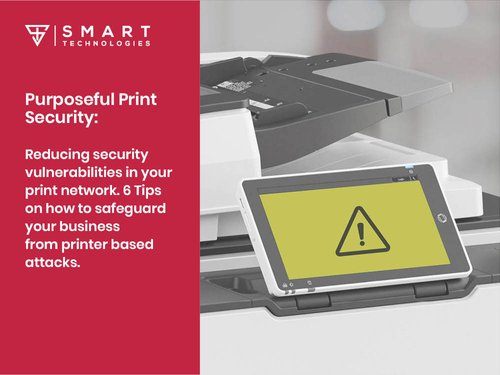Reducing security vulnerabilities in your print network. 6 Tips on how to safeguard your business from printer based attacks.
Effective strategies for reducing security vulnerabilities in your print network.
As today’s organizations are shifting work outside the office and being accessed via the cloud, businesses have increasingly become targets for cyber-attacks and data breach vulnerabilities. The need to create a comprehensive plan for purposeful print security within your traditional or hybrid environment is more important than ever before.

Print security is low on the IT security agenda but it shouldn’t be.
Based on the 531 IT professionals Quocirca interviewed for their most recent print security report it was uncovered that over two-thirds of organizations have experienced data losses due to insecure printing practices. If the data loss is due to a cyber-security breach, the financial impact could be immense-costing organizations over 750 thousand dollars per data breach in the US. Despite the large financial impact a security breach can bring about, print security still remains low on the IT security agenda with only 35% of IT professionals in the US rank office printers as a high-security risk.
How could a vulnerability impact your print network?
An insecure printer can be an easy entry point for deeper malicious network penetration. If compromised, the sensitive information transmitted through print jobs can be the source of data leaks. In addition to the transmission of private data, the actual printer can be taken over by a threat actor and converted to a botnet, used to send spam emails, transmit malware and viruses, initiate distributed denial-of-service attacks, and contribute to cyber-crime.
6 Tips on how to safeguard your business from printer based attacks.
1. Use End-to-End Encryption Across Your Print Network
Enabling End-to-End Encryption within your print network is a great way to add a security layer to the sensitive data transmitted to your print devices. Whether your print jobs are submitted through SMB (Typically Windows) or IPPS (Typically Mac), make sure your IT support staff test these network settings to ensure complete encryption and disable any unencrypted transmissions types- LPR/LPD is one example.
2. Be Vigilant with Firmware Updates & Patch Management
Printers are like any other IT device, they require consistent updates to the system firmware in an effort to patch vulnerabilities as they become known. Creating a firmware & software update game plan will help reduce the cyber-security risk to your print devices as these often can get overlooked by your IT support staff when other system updates.
3. Implement Print Watermarking & Digital Signatures on Print Jobs
Watermarking is a simple method of logging print jobs after they are released by including variable data, such as user, date/time, cryptographic signature and device information. While this type of feature will not directly prevent a cyber-attack, it may help speed up the remediation in the event of a network compromise. Tracking jobs can also aid your IT support staff with updating any misconfigured devices that are not sending print jobs under the uniform settings.
4. Consider Multi-Factor Authentication
This tip is focused more on your print management portal, however adding additional security in depth is a great way to beef up your cyber-security posture. Multi-Factor Authentication is a security setting that requires a combination of two or more authenticators to verify your identity before the service grants you access. Using MFA protects your account more than just using a username and password. Users who enable MFA are 99% less likely to get hacked, according to CISA. This feature can be enabled in your print management dashboard in most Print Management Systems.
5. Setup Spool File Encryption
In an office that runs a large job queue on your print server, enabling spool file encryption can be a simple step to add an additional security layer. Spool file encryption means that all print jobs are encrypted while they are temporary stored on the disk of the print provider and are waiting to be printed. Depending on your print network configuration, enabling this feature can be taken in many ways. Make sure to coordinate with your IT support staff on the best way to roll the security settings out.
6. Create a Print Logging & Archiving Policy
Keeping a record of your organization’s print activity & logs is another step you can take to increase the IT evidence you need in the event of a cyber-security breach. Print log data can be used to check for abnormal behavior, inspecting individual print documents, determining location & device identification of print suspicious print jobs ran. While most print system have a basic form of logs, enhancing the data collected and stored can be achieved through print management systems.
A Smart Start
Your office faces an ever increasing amount of cyber-security threats that doesn’t seem to be slowing down anytime soon. The print devices on your network tend to be the at the back of the line when it comes to increasing security awareness. These simple steps could help increase your security posture and put you on the right track to reduce your vulnerability & risk. However, you don’t have to go it alone, if you are looking for ways to secure your printing assets and maybe save some sanity, let us provide a free IT Print Network Risk Assessment today.











